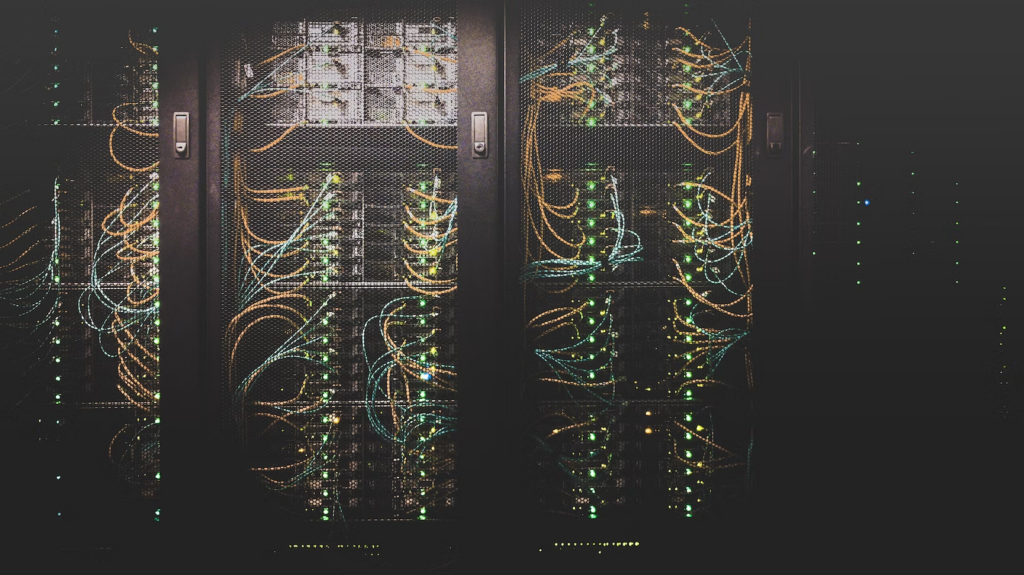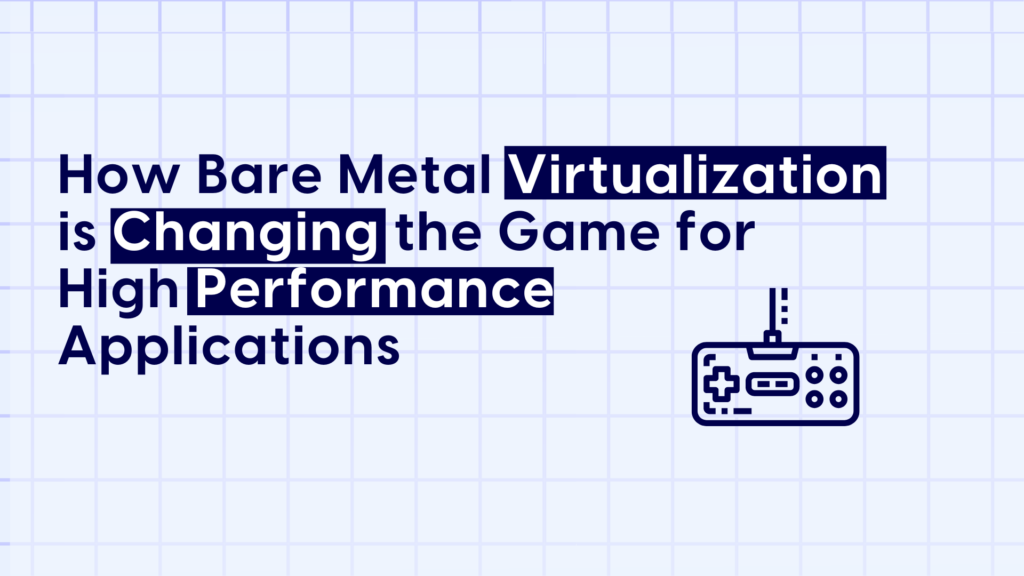Written
by edgeuno tech
Jun, 21, 2023
Last modified on Sep, 13, 2023 at 04:52 pm
How Bare Metal Virtualization Is Changing The Game For High-Performance Applications

Photo by Taylor Vick on Unsplash
In the era of digital transformation, high-performance applications have become the backbone of various industries. They enable organizations to process large volumes of data at record speeds, delivering robust solutions and insights that drive business growth.
However, these applications require substantial computational resources and a supportive infrastructure to operate at their peak. This is where bare metal virtualization enters the picture, dramatically changing the game for high-performance applications.
The Need For High-Performance Applications
The rapid growth of data and the increasing complexity of computing tasks have made high-performance applications indispensable across various industries. Here, we explore some of the key factors contributing to the increasing need for high-performance applications.
Real-Time Analytics
Businesses are now expected to make data-driven decisions faster than ever before. Real-time analytics enables organizations to extract actionable insights from their data as it is being generated, which allows them to respond to changes in the market or consumer behavior more quickly. High-performance applications play a crucial role in real-time analytics by processing and analyzing vast amounts of data almost instantaneously.
Big Data Processing
The volume, velocity, and variety of data being generated have grown exponentially in recent years, and this trend is set to continue. High-performance applications are required to handle big data processing tasks, such as filtering, cleaning, and transforming data, as well as executing complex algorithms and statistical analyses on massive datasets.
Artificial Intelligence And Machine Learning
AI and machine learning have become integral to many industries, powering everything from recommendation engines to self-driving cars. These technologies rely on high-performance applications to train and execute machine learning models, which often involve processing vast amounts of data and performing complex calculations in real time.
Computational Science And Research
High-performance applications are also essential in scientific research and simulations, where large-scale computations and data processing are crucial. Examples include weather forecasting, climate modeling, and molecular dynamics simulations. These applications require immense computing power and the ability to handle huge datasets to produce accurate and timely results.
Online Gaming And Media Streaming
The gaming and media streaming industries have witnessed exponential growth, with consumers demanding high-quality experiences with minimal latency. High-performance applications are required to support online gaming platforms, ensuring smooth and responsive gameplay for users. Similarly, media streaming services need high-performance applications to provide seamless, high-quality content delivery to users across various devices.
Financial Services
High-performance applications play a crucial role in financial services, where they are used for tasks such as risk management, fraud detection, and high-frequency trading. These applications need to process vast amounts of financial data in real time, making split-second decisions that can have significant impacts on the market and organizations’ bottom lines.
What Is Bare Metal Virtualization?

Photo by Adi Goldstein on Unsplash
Bare metal virtualization, also known as Type 1 or hypervisor-based virtualization, is a technology that allows multiple operating systems to run concurrently on a single physical server, directly on the physical hardware. This approach eliminates the need for a host operating system, offering a direct interface between the virtual machines (VMs) and the hardware resources.
How Bare Metal Virtualization Works
Bare metal virtualization technology works by installing a hypervisor directly onto the bare metal server’s hardware. The hypervisor is a thin layer of software that manages the physical resources and divides them among multiple virtual machines.
Each VM operates independently, with its own operating system and applications, while the hypervisor ensures that each VM has the resources it needs to operate effectively and isolates each VM from the others to prevent any potential interference.
How Does Bare Metal Virtualization Differ From Traditional Virtualization?
Traditional virtualization, also known as Type 2 or hosted virtualization, involves running VMs on top of a host operating system. In contrast, bare metal virtualization bypasses the host OS, eliminating a layer of overhead and potential performance degradation. This results in a higher degree of efficiency and performance, making it ideal for high-demand applications.
Advantages And Challenges Of Bare Metal Virtualization
Bare metal virtualization offers several advantages over traditional virtualization, such as a higher level of performance, increased isolation of VMs, improved security, as well as a higher degree of flexibility.
But while it offers many benefits, it also presents some challenges. These include the complexity of setup and management, the need for specialized skills to operate, and potential compatibility issues with certain applications or guest operating systems.
Advantages
Enhanced Performance
With bare metal virtualization, performance improvements are remarkable. By having the bare metal virtualization software interact directly with the dedicated hardware devices, it eliminates the need for an underlying host operating system, reducing overhead and latency. The result is faster execution of tasks and higher application performance, which is particularly beneficial for data-intensive, real-time, and high-performance applications.
Improved Security
Robust security is the result of each virtual machine being isolated, ensuring that an issue in one doesn’t affect the others, thus reducing the potential attack surface. Advanced types of hypervisors also offer advanced security features, including secure boot mechanisms, intrusion detection systems, and encryption, further bolstering the security of your virtualized environment.
Increased Scalability And Flexibility
Bare metal virtualization also provides great scalability and flexibility. As each VM operates independently, it’s easy to scale up or down based on business needs. Additionally, different operating systems can run concurrently on the same virtual server, enabling a wide variety of applications to coexist on a single piece of computing hardware.
Cost-Efficiency
Finally, hypervisor-based virtualization can lead to significant cost savings. By allowing multiple VMs to run on a single physical server, it reduces the need for additional hardware, resulting in lower capital expenditure. Moreover, it improves resource utilization, ensuring businesses get more value from their hardware investments.
Challenges
Complexity
Despite its many advantages, bare metal virtualization can be complex to set up and manage. It requires a deep understanding of server hardware, bare-metal hypervisor configurations, and virtualization principles. Consequently, it may necessitate specialized IT skills and hardware resources, which can be a significant hurdle for smaller organizations or those with less technical expertise.
Compatibility Issues
Not all operating applications and systems work seamlessly with all hypervisors. This requires thorough testing and validation before deployment, which can be time-consuming and may delay the implementation process.
Troubleshooting
Given the isolated nature of each VM, identifying and resolving issues can be more challenging, as problems cannot be isolated to a single operating system or application. This requires a deeper understanding of the virtual environment and may necessitate specialized tools or skills.
Transition And Training
Lastly, the transition to a bare metal environment can be a challenge. Existing systems and processes may need to be reconfigured or redesigned, which can be disruptive. Additionally, IT staff may require training to develop the necessary skills to manage and maintain the new environment effectively. It’s important to plan for these challenges and ensure sufficient support is in place to facilitate a smooth transition.
How To Adopt Bare Metal Virtualization

Photo by JESHOOTS.COM on Unsplash
Adopting bare metal virtualization can be a significant undertaking. However, with the right approach, you can ensure a smooth transition and realize the full benefits of this technology. Here are some steps to guide you through the process:
Understand Your Needs
Identify the high-performance applications that you’ll be running and their specific requirements in terms of processing power, memory, storage, and network connectivity. Moreover, determine the compatibility of these applications with different native hypervisors and their scalability requirements.
Choose The Right Hypervisor
Evaluate different bare-metal hypervisors based on their compatibility with your hardware and applications, performance, security features, ease of management, and support.
Plan Your Infrastructure
Once you’ve chosen bare metal virtualization software, plan your virtualization infrastructure. This includes deciding on the number of virtual machines you’ll need, the physical resources to allocate to each, and the way they’ll be networked. It’s also essential to plan for storage, considering factors such as performance, capacity, and redundancy.
Implement Security Measures
Ensure that your bare-metal hypervisor is secure and up-to-date, and take advantage of built-in security features. Implement additional measures as needed, such as firewalls, intrusion detection systems, and encryption. It’s also important to have a comprehensive plan for managing access to your virtualized environment.
Train Your Team
As bare metal virtualization requires specific skills to manage and troubleshoot, make sure your IT team has the necessary training to handle the new environment. This could involve attending courses, workshops, or online training programs offered by hypervisor vendors or third-party training providers.
Test And Validate
Before going live, thoroughly test your virtualization setup. This includes validating the performance, security, and compatibility of your virtual machines, as well as failover and recovery processes. Make any necessary adjustments based on your test results.
Monitor And Optimize
Once your virtualization environment is operational, it’s important to continually monitor and optimize it. Regularly review the performance and resource usage of your VMs, as well as adjust configurations as needed to ensure optimal performance and efficiency.
How To Choose The Right Bare Metal Virtualization Solution
Choosing the right bare metal virtualization solution depends on your organization’s specific needs and resources. Here are some factors to consider:
- Compatibility: Ensure the solution is compatible with your underlying hardware and the operating systems you intend to run.
- Performance: Look for a solution that can meet the performance demands of your high-performance applications.
- Security: Check the security features of the solution, ensuring it offers robust isolation and protection for your virtual resources.
- Manageability: Consider the ease of management of the solution, including the availability of monitoring and management tools.
- Support: Look for a solution backed by reliable support to help you address any issues that may arise.
Why Choose EdgeUno?
When it comes to choosing a provider for bare metal virtualization solutions, especially for high-performance computing (HPC) applications in Latin America and beyond, EdgeUno stands out as a leading choice. We offer a unique blend of cutting-edge technology, in-depth expertise, and localized services that sets us apart in the competitive landscape of cloud services.
Furthermore, EdgeUno is renowned for its infrastructure quality, customer service, and affordable pricing. This commitment to customer service enhances the overall customer experience and builds strong, long-term relationships.
Summary
Bare metal virtualization is a game-changing technology for high-performance applications. By providing improved performance, increased security, and greater efficiency, it offers a powerful solution for organizations looking to optimize their data processing capabilities.
While the transition to bare metal virtualization may present some challenges, with careful planning, the right solution, and adequate support, these can be successfully managed. The result is a high-performing, flexible, and secure environment that enables your high-performance applications to shine.
 Back to Blog
Back to Blog



